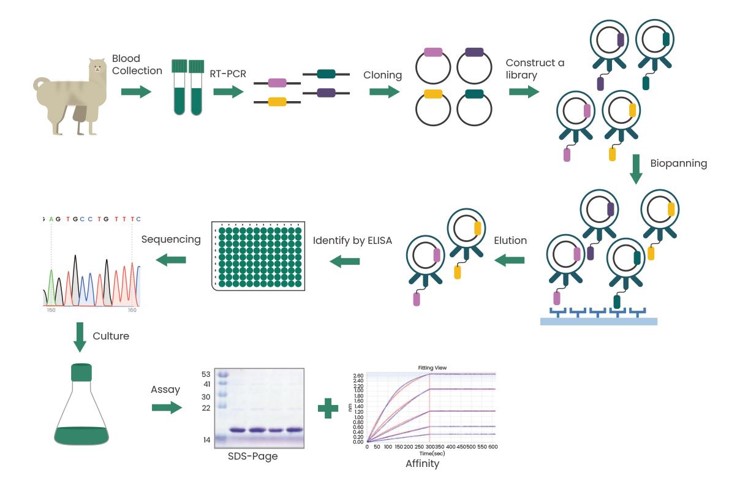Nanobody Discovery Service
Kanghui-Bio provides full-process nanobody development services.
Based on the mature phage display technology platform, Kanghui-Bio can provide customized nanoantibody services for a wide range of targets, including antigen expression and detection, alpaca immunity, potency assay, phage library construction, phage panning, high-specificity and high-affinity nanoantibody discovery, nanoantibody expression, and nanoantibody activity assay as a one-stop service.
Nanobody Introduction
Nanobodies are small, stable antibody molecules originally found in camelids (e.g. llamas and alpacas). They consist of the variable region (VHH) of a heavy chain antibody, which does not contain the conventional light chain, and are therefore much smaller (about 15 kDa), only about one-tenth of the size of conventional antibodies.
Nanobodies have several remarkable features:
- High affinity and stability: The CDR3 region of the nanobody can form a large exposed convex ring that extends like a ‘finger’ into the gap or cleft of the antigen, allowing access to antigenic epitopes that cannot be reached by conventional antibodies. In addition, nanoantibodies show good stability under high temperature, protease, pro-solvent and extreme pH conditions.
- Easy production and expression: nanobodies can be expressed in large quantities in microbial systems (e.g., bacteria, yeast, fungi) and can be rapidly screened in display libraries, giving nanobodies the advantage of lower production costs.
- Low immunogenicity: The structure of nanobodies is very similar to the structure of the heavy chain variable region VH of human antibodies, which means that nanobodies have low immunogenicity and are suitable for clinical treatment.
- Strong tissue penetration: Due to the small molecular weight, nanobodies have better tissue penetration and can reach lesions and tissues, such as solid tumors, that cannot be reached by traditional antibodies.
- Recognition of hidden antigenic epitopes: nanobodies can recognize hidden antigenic epitopes that are difficult to be recognized by conventional antibodies, and therefore have great potential in the treatment of infectious diseases such as COVID-19, and even in all disease areas.
- Ability to form multimers: With their small molecular weight, nanobodies can easily be genetically engineered to express multiple nanoantibody monomers in tandem to achieve multimers and enhance the binding ability of the antibody to the antigen.
These properties of nanobodies make them promising for a wide range of applications in drug development, diagnostic reagents and biotechnology. For example, caplacizumab, a nanobody developed by Sanofi for rare blood diseases, has been approved for marketing in the EU and the US, and is being studied for other diseases such as rheumatoid arthritis and lupus erythematosus. A research team from Fudan University has also discovered fully human nanobodies that target different epitopes on the receptor-binding region of COVID-19, which is important for the development of novel COVID-19 drugs and therapeutic options.
Nanobody Discovery Progress and Timeline
Nanobody Discovery Progress

Timeline





